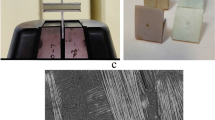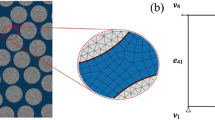Abstract
In this work, a new test set-up was applied in order to determine cohesive zone models experimentally. A high speed camera in combination with a digital image correlation system was used to record the local displacements enabling the detailed determination of crack opening values. The J-Integral method was used to calculate the cohesive stresses. The analyzed materials were composites made of glass fiber reinforced epoxy resin layers. Two different specimen geometries and the difference between warp and weft of the glass fiber mats were analyzed. As the specimen geometry didn’t have a significant influence, the difference between warp and weft, regarded by the loading direction, lead to considerably different cohesive zone laws. The initial part, the linear increase to a maximum stress, was very similar, while the damage evolution was either exponential or bilinear in shape. In future work, the derived cohesive zone models will be used to perform finite element simulations on laboratory specimens and on component scale. Thus, by comparison to the measurement result, the cohesive zone models can be evaluated.













Similar content being viewed by others
References
Barenblatt GI (1962) The mathematical theory of equilibrium cracks in brittle fracture. Adv Appl Mech 7:55–129
Dugdale DS (1960) Yielding of steel sheets containing slits. J Mech Phys Solids 8:100–104
Remmers JJC, de Borst R, Needleman A (2008) The simulation of dynamic crack propagation using the cohesive segments method. J Mech Phys Solids 56:70–92
Zhang Z, Paulino GH (2004) Cohesive zone modelling of dynamic failure in homogeneous and functionally graded materials. Int J Plasticity 21:1195–1254
Yang ZJ, Deeks AJ (2007) Fully-automatic modelling of cohesive crack growth using a finite element-scaled boundary finite element coupled method. Eng Fract Mech 74:2547–2573
Yang Q, Cox B (2005) Cohesive models for damage evolution in laminated composites. Int J Fract 133:107–137
Sørensen BF, Jacobsen TK (2003) Determination of cohesive laws by the J integral approach. Eng Fract Mech 70:1841–1858
Ting SKM, Williams JG, Ivankovic A (2006) Characterization of the fracture behaviour of polyethylene using measured cohesive curves. Polym Eng Sci 46:763–798
Li VC, Ward RJ (1989) A novel testing technique for post-peak tensile behaviour of cementitious materials. In: Mihashi et al (eds) Fracture toughness and fracture energy. Balkema, Rotterdam, pp 183–195
Chen CR, Kolednik O, Scheider I, Siegmund T, Tatschl A, Fischer FD (2003) On the determination of the cohesive zone parameters for the modeling of micro-ductile crack growth in thick specimens. Int J Fract 120:517–536
Zhu Y, Liechti KM, Ravi-Chandar K (2009) Direct extraction of rate-dependent traction-seperation laws for polyurea/steel interfaces. Int J Solids Struct 46:31–51
Rice JR (1968) A path independent integral and the approximate analysis of strain concentration by notches and cracks. J Appl Mech 35:379–386
Jerabek M, Major Z, Lang RW (2010) Strain determination of polymeric materials using digital image correlation. Polym Test 29:407–416
Turner CE (1980) The ubiquitous η factor. Fract Mech, 12th conference, ASTM-STP 700:314–337
Towers OL (1985) Tests for fracture toughness and fatigue assessment: a compilation of stress intensity, compliance, and elastic η factors. The Welding Institute, Abington
Bao G, Suo Z (1992) Remarks on crack-bridging concepts. Appl Mech Rev 45:354–366
Acknowledgements
The research work of this paper was performed at the Polymer Competence Center Leoben GmbH (PCCL, Austria) within the framework of the Kplus-program of the Austrian Ministry of Traffic, Innovation and Technology with contributions by the Institute of Material Science and Testing of Plastics, University of Leoben and AT&S GmbH. The PCCL is funded by the Austrian Government and the State Governments of Styria and Upper Austria.
Author information
Authors and Affiliations
Corresponding author
Rights and permissions
About this article
Cite this article
Fuchs, P.F., Major, Z. Experimental Determination of Cohesive Zone Models for Epoxy Composites. Exp Mech 51, 779–786 (2011). https://doi.org/10.1007/s11340-010-9370-2
Received:
Accepted:
Published:
Issue Date:
DOI: https://doi.org/10.1007/s11340-010-9370-2




